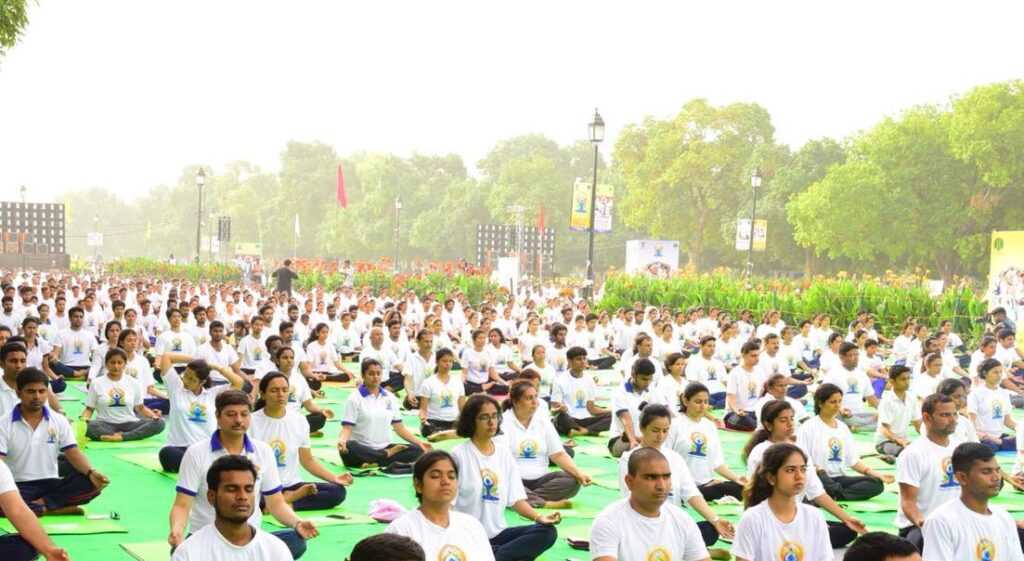
What is Polycystic Ovarian Syndrome?
Small cysts characterise polycystic ovarian syndrome in the ovary, where the women experience reproductive, psychological, and hormonal imbalances. About 5-10 % of women are diagnosed with PCOD—imbalances in hormonal production lead to an increase in the level of male hormones and insulin resistance. In PCOS, androgens are increased while progesterone is lowered, which increases testosterone production in the body.
Women suffer from hair fall, pimples, infertility, irregular MC, weight gain, etc. PCOD can also cause type 2 diabetes and heart attack. Yoga helps to balance hormones by reducing androgens and encouraging egg production.
Causes
There are many reasons for polycystic ovarian disorder, but stress is the most prominent one. Some of the important causes of PCOS are:
- Stress & strain
- Perennial tension
- Modern faulty lifestyle
- Anxiety
- Depression
Symptoms
Vital signs and symptoms of PCOS are as follows:
- Irregular MC
- Ovarian cyst
- Acne, pimples, and blemishes
- Hair loss
- Baldness similar to male
- Abdominal bloating
- Dandruff
- Frequent mood swings
- Miscarriage
- Irritability
- Hair growth on the face and rest of the body
- Weight
- Muscles and bone enlargement
- BP
- Blood sugar imbalance
Consequences
The risk factors of PCOD are as follows:
- Heart attack
- Diabetes
- Strokes
- Anxiety disorder
- Depression
- Uterine cancer
Yoga for Polycystic Ovarian Syndrome
Yoga can play an essential role in preventing and managing polycystic ovarian syndrome. Yoga is one of the crucial refreshing and rejuvenating modalities that can contend with and even root out stress completely since stress plays an essential factor in exaggerating PCOS, so yoga therapy is effective in PCOS.
Yoga poses such as asanas, relaxation exercises, pranayama, and meditation are effective stress busters. Yoga poses like asanas help stretch the pelvic area, and pranayama and meditation soothe the mind.
15 Yoga poses for polycystic Ovarian Syndrome prevention
Yoga helps regulate the body’s endocrine glands, thereby being beneficial in balancing hormones. Yoga effectively keeps your ovary and uterus healthy and solves infertility, weight gain, and psychological problems. Many yoga postures are suitable for PCOD. Some of the essential Yoga postures are given below.
- Nadisodhan Pranayama: Nadisodhan Pranayama is also called Anulom Vilom, which helps to soothe your mind and refresh your brain nerves, helping de-stress the body. It brings peace and comfort to your body, thus curing PCOS naturally.
- Bhramri Pranayama: It is the only pranayama that controls all the negative domains, such as stress, strain, anxiety, tension, depression, etc. So, it helps contend with your mood swings.
- Meditation will help stabilise your mind, act as a mood elevator, and facilitate a calming effect. Meditation brings harmony within the body, mind, and emotions to control PCOD naturally.
- Bhadrasana (Butterfly pose): This is an effective asana for those experiencing PCOD. It helps to open up the pelvic area and promote relaxation. It beats stress and relieves menstrual discomfort. The butterfly should be practised coolly and calmly.
- Sun Salutation (Surya Namaskar): The twelve Yoga poses in the Sun Salutation are suitable for enhancing flexibility in the body and effectively controlling hormonal imbalance. Surya Namaskar is also helpful in maintaining weight. Sun Salutation helps to detoxify and de-stress the entire system.
- Bhujangasana (Cobra pose): The cobra pose exerts pressure on the stomach and helps to stimulate ovarian function. It has many advantages like improved digestion, bust stress, and good for the chest, lungs, and shoulder.
- Naukasana (Boat Pose): Naukasana is good in the case of PCOS as the boat pose puts excess pressure on the abdominal region.
- Dhanurasana (Bow pose)
- Warrior pose (Superman pose)
- Supta Badhakonasana (Reclining Butterfly Pose)
- Bharadvajasana (Bharadvaja’s Twist)
- Chakki Chalanasana (moving the grinding wheel) helps to modify the endocrine glandular function, thus enhancing the efficiency of hormonal secretion.
- Shavasana (Corpse Pose)
- Padmasana helps to stretch the pelvic region and is sound to control hormonal imbalance.
- Kapalbhati
Diet tips for prevention of Polycystic Ovarian Syndrome
- Focus on protein and fresh vegetables
- Eat low GI and GL foods.
- Eat natural-based foods like eggs and fresh fruits.
- Eat good fats.
- Take a balanced and healthy diet
- Eat foods which are having enough fibre and roughage
- Avoid more sugary and carbohydrate foods.
- Low glycemic foods should be preferred.
- Low Low-saturated foods should be given importance.
- More weightage should be given to fresh fruits and fresh vegetables.
- Vitamin B6 helps to maintain hormone balance and is suitable for controlling PCOD.
- Vitamins B2, B3, B5, and B6 are good in controlling weight.
- Foods such as lentils and chickpeas should be taken as they reduce estrogen levels.
- Foods such as nuts, seeds, and olive oil should be encouraged as they contain essential fatty acid
- Use apple cider vinegar.
Eight tips to control Polycystic Ovarian Syndrome
- Drink an adequate quantity of water.
- Take fresh foods and fresh vegetables
- Avoid junk, fast, and processed foods
- Avoid milk and milk products.
- Avoid coffee and alcohol.
- One should do regular exercise, yoga, and a brisk walk to maintain his weight.
- Avoid faulty modern life instfocusingf focus on soothing music, nature & scenic beauty, gardening, and spending time at a natural place.
- Take fresh foods and salads







Awesome tips thanks
how many time do we have to perform this exercise
I am afraid of PCOS. Is this curable,?
For the majority of women with poly-cystic ovary syndrome, a primary cause of symptoms is the presence of a medical condition called “insulin resistance”. Insulin resistance simply means your cells are “resistant” to or are under-responding to the hormone insulin. Therefore, insulin cannot efficiently tell the cells to store blood sugar or perform a multitude of other tasks. The result is that the entire body is thrown into a state of imbalance and distress, leading to weight gain, belly fat, ovulation problems, mood disorders, and skin and hair issues.
May i know How much amount they charges for pcod problem in yoga mam.
Thanks its really good information
Thanku very very much.. .. This informations get great and better life to every person and people.. …
infos given are very helpful,,,,
thank u so much..
Thanks for every things
Is the stage of PCOS can be cured permanently and can lead a normal Life?
I recently found out that i am diagnosed with PCOS. I was so chaotic i always had a terrible back pain during 2 years which goes into my legs. Now i am taking treatment. But i want to know Is milk good for girls with PCO’s?
Good guidance for people
really really so helpful tips thanku, but i want to ask whether medicines containing vitamin B complex are good in PCOD ???? I have heard its not good!! kindly do tell me
PCOD these days is common in women’s and i was one of the victim of this disease. I lost all my hopes after trying lots of medicines and spend lots of money, after that problem was still there. Periods were only regular due to medicines after leaving the medicines the problem reoccurs. Then one of relative suggested me ayurvedic treatment. Selecting right product was again a problem as there were lots of ayurvedic product and i chose arogyam pcod kit and my decision was right . Thanks to Arogyam products now i am PCOD free lady and mother of 2 kids….